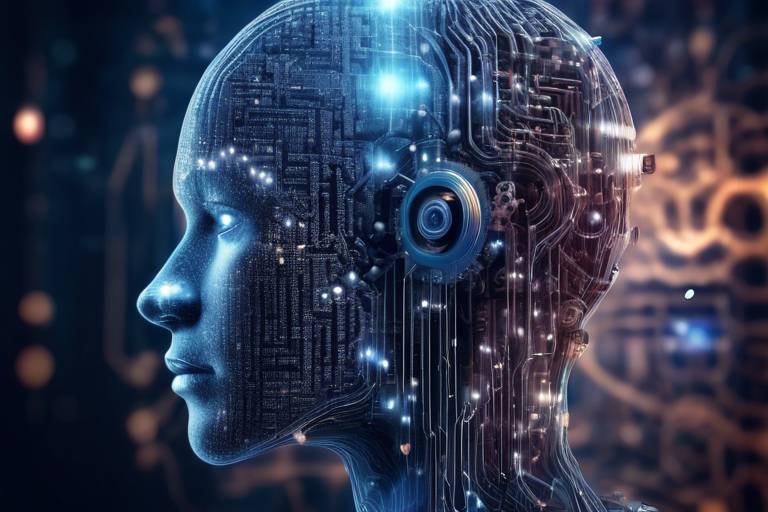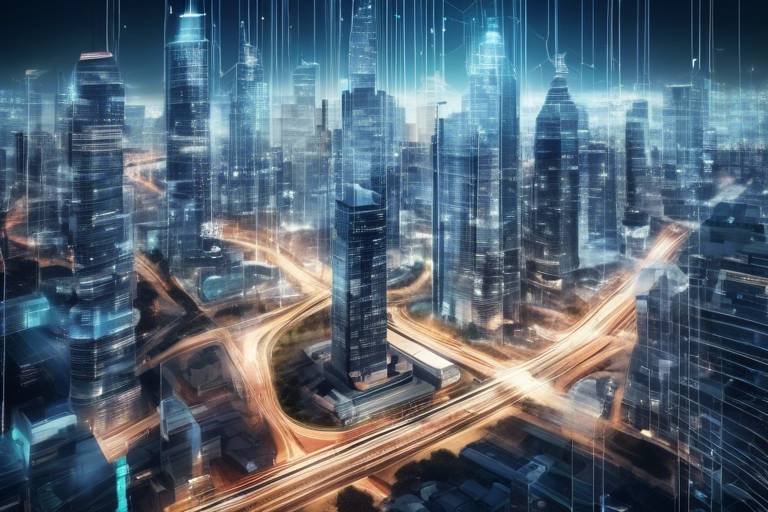Impact of AI Innovations on Climate Change
The world is at a critical juncture, facing the pressing challenges of climate change that threaten our very existence. As we grapple with rising temperatures, unpredictable weather patterns, and the depletion of natural resources, one thing is clear: we need innovative solutions. Enter artificial intelligence (AI), a game-changer that is transforming how we approach environmental issues. AI technologies are not just buzzwords; they are powerful tools that are reshaping climate change mitigation efforts across various sectors. From enhancing predictive capabilities in climate modeling to optimizing renewable energy systems, AI is proving to be an invaluable ally in our fight against environmental degradation.
Imagine a world where we can accurately predict climate patterns, optimize energy usage, and even capture carbon emissions with unparalleled efficiency. This is not science fiction; this is the reality that AI is helping to create. By harnessing vast amounts of data and employing sophisticated algorithms, AI can provide insights that were previously unimaginable. It allows us to understand the intricate web of climate interactions and develop strategies that are not only effective but also sustainable.
Moreover, the integration of AI into climate initiatives is fostering collaboration across industries. Businesses, governments, and researchers are leveraging AI-driven solutions to address environmental challenges collectively. For instance, AI can facilitate better resource management in agriculture, optimize supply chains to reduce carbon footprints, and even enhance urban planning to create more resilient cities. The potential applications are vast, and the impact can be profound.
As we delve deeper into the specifics, we will explore how AI is revolutionizing climate modeling, optimizing renewable energy systems, advancing carbon capture technologies, and aiding in climate change adaptation strategies. Each of these areas represents a crucial aspect of our efforts to combat climate change and highlights the transformative power of AI in creating a sustainable future.
- How does AI improve climate modeling?
AI algorithms enhance the accuracy of climate predictions by processing large datasets and identifying complex patterns that traditional methods may overlook. - What role does AI play in renewable energy?
AI optimizes energy production and distribution, ensuring that renewable sources like solar and wind are used efficiently, thereby reducing reliance on fossil fuels. - Can AI help in carbon capture?
Absolutely! AI technologies improve the monitoring and management of carbon capture processes, making them more viable for large-scale implementation. - How does AI assist in disaster risk management?
AI analyzes data to predict extreme weather events, enabling communities to prepare and respond effectively to potential disasters.

AI in Climate Modeling
Artificial Intelligence (AI) is fundamentally transforming climate modeling by enhancing the accuracy and reliability of predictive analytics. Traditional climate models often struggled with the complexity of climate systems, leading to uncertainties in forecasting. However, with the advent of AI algorithms, scientists can now process vast amounts of data at unprecedented speeds, allowing for a more nuanced understanding of climate patterns. Imagine having a super-intelligent assistant that can sift through mountains of data and find the hidden trends that humans might miss—this is exactly what AI brings to the table.
One of the most significant advancements is the ability of AI to identify patterns in historical climate data and correlate them with current trends. This capability enables researchers to make more accurate predictions about future climate scenarios. For instance, AI can analyze data from various sources, such as satellite imagery, ocean temperatures, and atmospheric conditions, to create a comprehensive picture of our planet's climate dynamics. This is akin to putting together a jigsaw puzzle where each piece represents a different aspect of the climate system.
Moreover, AI's predictive capabilities are not just limited to forecasting weather patterns; they extend to understanding the potential impacts of climate change on ecosystems and human activities. By using machine learning techniques, AI models can simulate various climate scenarios and assess their potential impacts on biodiversity, agriculture, and urban areas. This allows policymakers to make informed decisions based on data-driven insights rather than guesswork.
In addition to predictive modeling, AI also plays a crucial role in adapting existing models to incorporate new data continuously. As climate science evolves and new data becomes available, AI systems can update their algorithms to reflect the latest findings. This adaptability is vital in a field where conditions are constantly changing, and new challenges arise. For example, AI can help refine models to account for unexpected events like wildfires or hurricanes, allowing for more accurate real-time assessments.
To illustrate the impact of AI on climate modeling, consider the following table:
| AI Technique | Application in Climate Modeling | Benefits |
|---|---|---|
| Machine Learning | Predicting temperature changes | Higher accuracy in forecasts |
| Neural Networks | Analyzing complex climate patterns | Improved understanding of interactions |
| Data Assimilation | Integrating real-time data | Dynamic model adjustments |
As we delve deeper into the realm of AI in climate modeling, it becomes clear that these technologies are not just tools; they are essential partners in our quest to understand and combat climate change. By leveraging AI, we can enhance our predictive capabilities, improve the accuracy of our models, and ultimately make better-informed decisions that will shape a sustainable future. The synergy between AI and climate science is paving the way for groundbreaking innovations that hold the potential to significantly mitigate the effects of climate change.
In conclusion, the integration of AI into climate modeling represents a paradigm shift in how we approach environmental challenges. With its ability to analyze data, identify patterns, and adapt to new information, AI is not only improving our understanding of climate dynamics but also equipping us with the tools needed to tackle one of the most pressing issues of our time. As we continue to explore these innovations, the future looks promising for both our planet and the generations to come.

Renewable Energy Optimization
Artificial intelligence (AI) is not just a buzzword; it's a game changer in the realm of renewable energy optimization. Imagine a world where energy systems operate at peak efficiency, where the sun and wind are harnessed without waste, and where energy is stored and distributed seamlessly. This is not a distant dream—it's becoming a reality thanks to AI technologies. By analyzing vast amounts of data, AI can predict energy production from renewable sources, optimize their usage, and significantly reduce carbon emissions. It’s like having a personal assistant for our energy needs, ensuring that we use just what we need when we need it.
One of the most exciting aspects of AI in renewable energy is its ability to enhance the efficiency of energy production, storage, and distribution. For instance, AI algorithms can analyze weather patterns, energy consumption trends, and grid conditions to make real-time decisions that maximize output and minimize waste. This level of optimization not only increases the reliability of renewable energy sources but also makes them more competitive with traditional fossil fuels. Think of it as a conductor leading an orchestra, ensuring that every instrument plays in harmony to create a beautiful symphony of energy.
AI-driven smart grid technologies are at the forefront of this revolution. These systems allow for real-time data analysis and improved decision-making, transforming how energy is consumed and distributed. With smart grids, the flow of electricity can be adjusted dynamically based on demand, ensuring that supply meets consumption efficiently. Imagine a bustling city where energy flows smoothly, adapting to the needs of its inhabitants without any hiccups. This is the promise of smart grid technologies powered by AI.
One of the critical components of smart grids is demand response systems. These systems utilize AI to adjust energy consumption based on availability, helping to balance supply and demand while alleviating peak load pressures on the grid. For example, during peak hours, AI can communicate with smart appliances in homes and businesses, asking them to reduce their energy usage temporarily. This not only prevents blackouts but also encourages consumers to engage in energy-saving practices. It’s like having a traffic cop directing the flow of energy, ensuring that everything runs smoothly.
Another significant advantage of AI in renewable energy optimization is predictive maintenance. By utilizing machine learning algorithms, AI can forecast equipment failures before they occur, minimizing downtime in renewable energy facilities. This means wind turbines can operate continuously without unexpected interruptions, maximizing energy production. Picture a well-oiled machine that never stops running; that's the potential of predictive maintenance in the renewable energy sector.
AI technologies are also being employed to enhance energy efficiency in buildings. Through smart automation, AI optimizes heating, cooling, and lighting systems, ensuring that energy consumption is reduced without sacrificing comfort. For instance, AI can learn a building's occupancy patterns and adjust the heating or cooling accordingly. This not only cuts costs but also contributes to a significant decrease in overall energy use. It’s like having a thermostat that knows exactly how warm or cool you like it, adjusting itself automatically to create the perfect environment.
| AI Applications in Renewable Energy | Description |
|---|---|
| Smart Grid Technologies | Enhances energy management through real-time data analysis. |
| Demand Response Systems | Adjusts energy consumption based on availability to balance supply and demand. |
| Predictive Maintenance | Forecasts equipment failures to minimize downtime in renewable energy facilities. |
| Energy Efficiency in Buildings | Optimizes heating, cooling, and lighting systems for reduced consumption. |
In conclusion, the integration of AI into renewable energy optimization is not just a technological advancement; it’s a vital step towards a sustainable future. By enhancing efficiency and reducing emissions, AI is paving the way for a cleaner, greener planet. As we continue to innovate and embrace these technologies, we move closer to a world where renewable energy is not just an alternative but the primary source of power for all.
- How does AI improve energy efficiency? AI improves energy efficiency by analyzing data to optimize energy usage in real-time, reducing waste and costs.
- What are smart grid technologies? Smart grid technologies use AI to manage and distribute electricity more efficiently, adapting to changes in demand and supply.
- Can AI predict equipment failures in renewable energy systems? Yes, AI can forecast potential failures through predictive maintenance, ensuring continuous operation of renewable energy facilities.
- How do demand response systems work? Demand response systems adjust energy consumption based on availability, helping to balance the grid and prevent overloads.

Smart Grid Technologies
Imagine a world where energy flows as smoothly as water through a pipe, where every drop of electricity is utilized efficiently, and where homes and businesses can communicate with the power grid in real time. This is the promise of , a revolutionary approach to energy management that harnesses the power of artificial intelligence (AI) to optimize our energy systems. By integrating advanced sensors, communication technologies, and AI algorithms, smart grids transform the traditional energy landscape into a dynamic, responsive network that enhances efficiency and sustainability.
At the heart of smart grid technologies is the ability to analyze vast amounts of data in real time. With AI, energy providers can monitor consumption patterns, predict demand fluctuations, and manage resources more effectively. This leads to a multitude of benefits:
- Enhanced Energy Efficiency: Smart grids enable precise energy distribution, ensuring that energy is delivered where and when it is needed most.
- Reduced Operational Costs: By optimizing energy flow and reducing waste, smart grids help utilities lower their operational expenses.
- Increased Reliability: AI-driven systems can quickly identify and resolve issues, minimizing outages and improving overall service reliability.
Furthermore, smart grid technologies empower consumers by providing them with insights into their energy usage. With smart meters and connected devices, households can track their energy consumption in real time, enabling them to make informed decisions about their energy use. This not only promotes energy conservation but also allows consumers to take advantage of demand response programs, where they can adjust their usage during peak times in exchange for financial incentives.
One of the most exciting aspects of smart grid technologies is their ability to integrate renewable energy sources. As more solar panels and wind turbines come online, the demand for a flexible and responsive energy system grows. Smart grids can seamlessly incorporate these variable energy sources, balancing supply and demand while reducing reliance on fossil fuels. This transition is crucial in the fight against climate change, as it helps lower carbon emissions and supports a cleaner, more sustainable future.
In summary, smart grid technologies represent a significant leap forward in energy management. By leveraging AI to enhance efficiency, reliability, and sustainability, these systems pave the way for a greener future. As we continue to embrace these innovations, we move closer to a world where energy is not just consumed, but managed intelligently, benefiting both consumers and the planet.
- What are smart grids? Smart grids are advanced energy systems that use digital technology to monitor and manage the transport of electricity from all generation sources to meet the varying electricity demands of end users.
- How do smart grids benefit consumers? Smart grids provide consumers with real-time information about their energy usage, enabling them to make informed decisions, reduce costs, and participate in demand response programs.
- Can smart grids integrate renewable energy sources? Yes, smart grids are designed to accommodate and optimize the integration of renewable energy sources like solar and wind, making energy systems more sustainable.
- What role does AI play in smart grids? AI enhances the functionality of smart grids by analyzing large datasets for predictive maintenance, real-time monitoring, and optimizing energy distribution.

Demand Response Systems
Demand response systems are a game-changer in the realm of energy management. Imagine a world where energy consumption adapts in real-time to the availability of renewable resources. That's precisely what these systems do! By leveraging artificial intelligence, demand response systems can dynamically adjust energy use based on current supply and demand conditions. This not only helps in balancing the grid but also significantly reduces the stress on energy resources during peak hours.
But how exactly do these systems work? At their core, demand response systems analyze data from various sources, including weather forecasts, energy usage patterns, and grid conditions. When energy demand spikes, these systems can automatically reduce or shift energy usage in response. For instance, if a utility company predicts a high demand period, they can send signals to smart appliances in homes and businesses to temporarily reduce their energy consumption. This might mean delaying the operation of a dishwasher or adjusting the thermostat slightly. The result? A more balanced grid and lower energy costs for consumers.
Moreover, demand response systems can be categorized into two main types: automated and manual. Automated systems utilize AI to make real-time adjustments without human intervention, while manual systems require users to respond to alerts and adjust their consumption accordingly. Both types play a vital role in enhancing energy efficiency and promoting sustainability.
As we move towards a greener future, the importance of demand response systems cannot be overstated. They not only contribute to reducing carbon emissions but also empower consumers to take an active role in energy management. By participating in demand response programs, consumers can benefit from lower energy bills and even receive incentives from utility companies. It's a win-win situation!
In summary, demand response systems represent a significant advancement in how we manage energy consumption. Through the integration of AI technologies, these systems enhance grid stability, promote energy efficiency, and ultimately contribute to a more sustainable future. The shift towards smarter energy use is not just a trend; it's an essential step in combating climate change and ensuring a reliable energy supply for generations to come.
- What is a demand response system?
A demand response system is a technology that allows for the adjustment of energy consumption in response to supply conditions, thereby helping to balance the energy grid. - How does AI enhance demand response systems?
AI improves the predictive capabilities of demand response systems, enabling real-time adjustments based on data analysis of energy usage and grid conditions. - Can consumers benefit from participating in demand response programs?
Yes, consumers can enjoy lower energy costs and may receive incentives from utility companies for participating in these programs.

Predictive Maintenance
Predictive maintenance is a game-changer in the renewable energy sector, and it's all thanks to the power of artificial intelligence. Imagine being able to foresee potential equipment failures before they actually happen, much like a weather forecast that tells you to grab an umbrella before the rain starts. This proactive approach not only minimizes downtime but also ensures that energy production remains steady and efficient. By leveraging AI algorithms, companies can analyze vast amounts of data from sensors embedded in wind turbines, solar panels, and other renewable energy systems.
These algorithms process real-time information to detect anomalies and predict when maintenance is needed. For instance, if a wind turbine's vibration levels start to deviate from the norm, AI can alert technicians to investigate before a minor issue turns into a costly breakdown. This not only saves money but also significantly boosts the overall reliability of renewable energy sources. In fact, studies have shown that predictive maintenance can increase operational efficiency by up to 25%, which is no small feat in the quest for sustainability.
Moreover, the implementation of predictive maintenance leads to a more sustainable approach to energy production. By reducing the frequency of unexpected repairs and ensuring that equipment is operating at peak performance, we can lower the carbon footprint associated with maintenance activities. This is crucial as the world strives to meet ambitious climate goals. The benefits of predictive maintenance extend beyond just operational improvements; they also contribute to a more resilient energy infrastructure.
To illustrate the impact of predictive maintenance, consider the following table that highlights key advantages:
| Advantage | Description |
|---|---|
| Reduced Downtime | Minimizes unexpected equipment failures, ensuring continuous energy production. |
| Cost Savings | Prevents costly repairs and extends the lifespan of equipment. |
| Enhanced Efficiency | Optimizes energy production by ensuring equipment operates at peak performance. |
| Sustainability | Contributes to reduced carbon emissions by maintaining efficient operations. |
In conclusion, predictive maintenance powered by AI is not just a technological advancement; it's a vital strategy for the future of renewable energy. By embracing this innovative approach, we can ensure that our energy systems are not only efficient but also resilient against the challenges posed by climate change. As we continue to innovate and integrate AI into our maintenance practices, we move closer to a sustainable future where energy production aligns seamlessly with environmental preservation.
- What is predictive maintenance? Predictive maintenance is a proactive approach that uses AI and data analysis to predict when equipment will need maintenance, preventing unexpected failures.
- How does AI improve predictive maintenance? AI algorithms analyze real-time data from equipment sensors to identify patterns and anomalies, allowing for timely interventions.
- What are the benefits of predictive maintenance in renewable energy? Benefits include reduced downtime, cost savings, enhanced operational efficiency, and a smaller carbon footprint.
- Can predictive maintenance be applied to other industries? Yes, predictive maintenance can be utilized in various sectors, including manufacturing, transportation, and healthcare, to improve operational efficiency.

Energy Efficiency in Buildings
In today's world, where energy consumption is at an all-time high and climate change looms large, the need for has never been more critical. With artificial intelligence (AI) stepping into the spotlight, we are witnessing a remarkable transformation in how buildings consume energy. Imagine a world where your home or office automatically adjusts its heating, cooling, and lighting based on real-time data and occupancy patterns. This isn't science fiction; it's the reality brought forth by AI technologies.
AI-driven solutions are not just about making buildings smarter; they are about making them more sustainable. By utilizing sophisticated algorithms, AI systems can analyze data from various sources, such as weather forecasts and occupancy sensors, to optimize energy use. For instance, during the hottest part of the day, the system can adjust the air conditioning to maintain comfort without wasting energy. This kind of intelligent automation can lead to significant reductions in energy consumption, ultimately lowering utility bills and decreasing the carbon footprint of buildings.
One of the most exciting applications of AI in energy efficiency is the integration of smart building technologies. These technologies allow for seamless communication between various systems, such as HVAC (heating, ventilation, and air conditioning), lighting, and security. When these systems work together, they create an environment that is not only comfortable but also energy-efficient. For example, if a room is unoccupied, the AI can automatically turn off the lights and adjust the temperature, ensuring that energy is not wasted.
Moreover, AI can predict energy needs based on historical data and current trends. By analyzing patterns in energy usage, AI can forecast peak times and adjust energy distribution accordingly. This predictive capability is particularly beneficial for large commercial buildings, where energy demands can fluctuate significantly throughout the day. The result is a more balanced energy load, which can lead to reduced strain on the grid and lower energy costs.
To illustrate the impact of AI on energy efficiency, consider the following table that compares traditional energy management systems with AI-enhanced systems:
| Feature | Traditional Systems | AI-Enhanced Systems |
|---|---|---|
| Data Analysis | Manual monitoring | Real-time analytics |
| Energy Adjustment | Scheduled settings | Dynamic adjustments based on usage |
| Occupancy Detection | Basic sensors | Smart occupancy tracking |
| Cost Savings | Minimal | Significant |
As we look to the future, the role of AI in enhancing energy efficiency in buildings will only grow. With ongoing advancements in machine learning and data analytics, we can expect even more innovative solutions that will help us combat climate change and create a sustainable living environment. The integration of AI in building management systems is not just a trend; it’s a necessity for a greener future.
- How does AI improve energy efficiency in buildings? AI optimizes energy consumption by analyzing real-time data and adjusting systems like heating, cooling, and lighting based on actual needs.
- What are smart building technologies? Smart building technologies are systems that allow different building functions to communicate and work together to enhance efficiency and comfort.
- Can AI help reduce energy costs? Yes, by optimizing energy usage and reducing waste, AI can lead to significant cost savings on energy bills.
- Is the implementation of AI in buildings expensive? While there may be initial costs, the long-term savings and benefits often outweigh these expenses, making it a worthwhile investment.

Carbon Capture and Storage
The fight against climate change has taken on many forms, but one of the most promising approaches is Carbon Capture and Storage (CCS). This innovative technology is like a giant sponge, soaking up the carbon dioxide (CO2) emissions produced by power plants and industrial processes before they can escape into the atmosphere. By capturing CO2 and storing it safely underground, we can significantly reduce the greenhouse gases contributing to global warming. But how does this work, and what role does artificial intelligence play in making CCS more effective?
AI innovations are enhancing CCS techniques by improving the monitoring and management of captured carbon. Imagine trying to find a needle in a haystack; that’s what it used to be like trying to track emissions. Now, with AI, we can analyze vast amounts of data to pinpoint where emissions are coming from and how best to capture them. This real-time data analysis allows organizations to optimize their carbon capture systems, ensuring that they operate at peak efficiency.
One of the key challenges in CCS is ensuring that the captured CO2 is stored securely and does not leak back into the atmosphere. Here, AI comes into play again. By utilizing advanced machine learning algorithms, we can predict potential leakage points and monitor storage sites with unprecedented accuracy. This not only enhances the safety of CCS operations but also builds public trust in the technology. After all, if people believe that CCS can be managed effectively, they are more likely to support its implementation.
Moreover, AI is paving the way for innovative carbon utilization methods. Instead of merely storing CO2, researchers are exploring ways to transform it into valuable products, such as fuels, chemicals, and even building materials. This concept is akin to turning waste into gold. For instance, captured CO2 can be converted into synthetic fuels that can power our cars and planes, thereby closing the carbon loop and contributing to a circular economy. This not only mitigates climate impacts but also creates new economic opportunities.
To illustrate the potential of CCS and AI integration, consider the following table that outlines the benefits of implementing AI in carbon capture technologies:
| Benefit | Description |
|---|---|
| Improved Efficiency | AI optimizes the carbon capture process, ensuring maximum CO2 is captured with minimal energy use. |
| Real-time Monitoring | AI systems provide continuous data on CO2 levels, helping to ensure safe storage practices. |
| Predictive Maintenance | AI forecasts equipment failures, reducing downtime and maintaining operational efficiency. |
| Innovative Utilization | AI drives research into converting CO2 into useful products, promoting sustainability. |
In conclusion, the integration of artificial intelligence into carbon capture and storage technologies is not just a trend; it's a necessity in our battle against climate change. As we harness the power of AI to enhance CCS, we are not only improving our ability to capture carbon but also paving the way for a more sustainable future. With continued innovation and investment, CCS can become a cornerstone of our climate strategy, helping to secure a healthier planet for generations to come.
- What is Carbon Capture and Storage (CCS)? CCS is a technology that captures carbon dioxide emissions from sources like power plants and stores it underground to prevent it from entering the atmosphere.
- How does AI improve CCS? AI enhances CCS by providing real-time monitoring, optimizing efficiency, and predicting maintenance needs, ensuring the systems operate effectively.
- Can captured CO2 be reused? Yes! AI is helping to develop methods to convert captured CO2 into valuable products, contributing to a circular economy.
- Is CCS safe? With advanced monitoring and management using AI, CCS can be implemented safely, minimizing the risk of CO2 leakage.

Monitoring Emissions
In the ongoing battle against climate change, monitoring greenhouse gas emissions has become a crucial component. Thanks to the advent of artificial intelligence, tracking these emissions has reached unprecedented levels of accuracy and efficiency. AI systems are designed to analyze vast amounts of data from various sources, enabling organizations to gain insights into their carbon footprints and implement effective reduction strategies.
These AI-driven systems utilize advanced algorithms to process data from sensors, satellite imagery, and other monitoring tools. By doing so, they can provide real-time insights into emission levels, identifying not just the amount of greenhouse gases being released, but also the specific sources. Imagine having a digital watchdog that not only alerts you to pollution but also tells you exactly where it’s coming from—this is the power of AI in emission monitoring.
Furthermore, AI can help organizations comply with environmental regulations by providing accurate reporting and documentation. This capability is essential, as regulatory frameworks become increasingly stringent. By ensuring compliance, companies can avoid hefty fines and contribute positively to environmental sustainability. The integration of AI in monitoring systems has paved the way for more transparent practices, fostering trust among stakeholders and the community.
To illustrate the impact of AI on emission monitoring, consider the following table that outlines the key benefits:
| Benefit | Description |
|---|---|
| Real-Time Data Analysis | AI systems provide immediate insights into emission levels, allowing for quick responses to environmental changes. |
| Source Identification | Advanced algorithms pinpoint specific sources of emissions, enabling targeted mitigation efforts. |
| Regulatory Compliance | AI helps organizations meet regulatory requirements through accurate reporting and monitoring. |
| Predictive Analytics | By analyzing historical data, AI can forecast future emissions, aiding in proactive planning. |
Moreover, the ability to leverage predictive analytics is another game-changer. By analyzing historical data, AI can forecast future emissions trends, allowing organizations to plan and implement strategies that preemptively address potential spikes in greenhouse gases. This proactive approach not only enhances compliance but also promotes a culture of sustainability within organizations.
In conclusion, the integration of AI in monitoring emissions is not just a technological advancement; it is a fundamental shift in how we approach environmental accountability. By harnessing the power of AI, we can ensure that our efforts to combat climate change are informed, effective, and sustainable. As we continue to innovate and refine these technologies, the potential for a cleaner, greener future becomes increasingly attainable.
- What is the role of AI in monitoring emissions? AI enhances the accuracy and efficiency of tracking greenhouse gas emissions by analyzing large datasets in real-time.
- How does AI help in regulatory compliance? AI systems provide accurate reporting and documentation, ensuring organizations meet environmental regulations.
- Can AI predict future emissions? Yes, through predictive analytics, AI can forecast emissions trends based on historical data.
- What are the benefits of real-time data analysis? It allows organizations to respond quickly to environmental changes, improving their mitigation efforts.

Innovative Carbon Utilization
In the quest to combat climate change, has emerged as a game-changer, transforming captured carbon dioxide (CO2) into valuable resources. Imagine turning a harmful pollutant into something useful—this is the magic of carbon utilization! By harnessing the power of artificial intelligence (AI), researchers and companies are developing groundbreaking methods to repurpose CO2, thereby contributing to a more sustainable future. The potential applications are as diverse as they are exciting, ranging from producing fuels and chemicals to creating building materials.
One of the most fascinating aspects of carbon utilization is its ability to integrate with existing industrial processes. For instance, AI can optimize the conversion of CO2 into synthetic fuels, which can be used to power vehicles or generate electricity. This not only reduces the amount of CO2 in the atmosphere but also provides a renewable energy source. Furthermore, the use of AI in this context allows for a more efficient process, minimizing energy consumption and maximizing output.
Another innovative approach is the transformation of CO2 into everyday products. For example, companies are experimenting with turning captured CO2 into plastics, which can then be used to manufacture various goods. This not only helps reduce waste but also lowers the demand for fossil fuels, which are traditionally used in plastic production. The potential for a circular economy is immense, as captured carbon can be continuously reused rather than being released back into the atmosphere.
To illustrate the impact of innovative carbon utilization, consider the following table showcasing some of the promising technologies and their applications:
| Technology | Application | Benefits |
|---|---|---|
| Synthetic Fuels | Transportation and energy generation | Reduces reliance on fossil fuels, lowers emissions |
| Carbon-based Plastics | Manufacturing consumer goods | Decreases plastic waste, reduces fossil fuel demand |
| Building Materials | Construction industry | Lower carbon footprint, sustainable building practices |
The integration of AI in these processes not only enhances efficiency but also allows for real-time monitoring and optimization. For instance, AI algorithms can analyze data from various sources to determine the best conditions for CO2 conversion, ensuring that the process is both cost-effective and environmentally friendly. This level of precision is crucial as we strive to make carbon utilization a viable solution in our fight against climate change.
In conclusion, innovative carbon utilization represents a beacon of hope in the battle against climate change. By leveraging AI technologies to transform CO2 into valuable products, we can not only reduce greenhouse gas emissions but also pave the way for a more sustainable and circular economy. As research and development in this field continue to advance, the possibilities are endless, and the impact could be monumental for our planet's future.
- What is carbon utilization? Carbon utilization refers to the process of converting captured carbon dioxide into valuable products, helping to reduce greenhouse gas emissions.
- How does AI contribute to carbon utilization? AI enhances the efficiency and effectiveness of carbon conversion processes by optimizing conditions and monitoring real-time data.
- What are some products made from captured CO2? Captured CO2 can be transformed into synthetic fuels, plastics, and building materials, among other products.
- Why is carbon utilization important? It helps mitigate climate change by reducing atmospheric CO2 levels while simultaneously providing valuable resources.

Climate Change Adaptation Strategies
As we grapple with the ever-growing challenges posed by climate change, adaptation strategies are becoming increasingly vital. These strategies are not just about surviving the changes; they are about thriving amidst them. Artificial Intelligence (AI) is stepping up as a powerful ally in this battle, enabling us to develop innovative solutions that enhance our resilience against climate impacts. Imagine AI as a skilled navigator, guiding us through the turbulent waters of climate change, helping communities to prepare, respond, and recover more effectively.
One of the key areas where AI is making a significant impact is in disaster risk management. By analyzing vast datasets, AI can predict extreme weather events with remarkable accuracy. Think of it as having a crystal ball that allows communities to foresee potential disasters, such as hurricanes or floods, long before they strike. This foresight enables timely evacuations, resource allocation, and emergency preparedness, ultimately saving lives and reducing damage.
Additionally, AI tools are revolutionizing urban planning and resilience. Urban planners are now equipped with advanced AI technologies that help them design cities capable of withstanding climate change impacts. These tools optimize land use and improve infrastructure, ensuring that cities are not only sustainable but also resilient. For instance, AI can analyze traffic patterns and population density to recommend the best locations for green spaces, which can help mitigate urban heat and enhance community well-being.
To illustrate the importance of these strategies, consider the following table that highlights some of the AI-driven adaptation strategies and their benefits:
| Adaptation Strategy | AI Application | Benefits |
|---|---|---|
| Disaster Risk Management | Predictive analytics for extreme weather | Improved preparedness and response |
| Urban Planning | Data analysis for land use optimization | Resilient infrastructure and sustainable development |
| Agricultural Adaptation | AI for crop yield prediction | Enhanced food security and resource management |
| Water Resource Management | AI for monitoring and forecasting | Efficient water usage and conservation |
Moreover, AI is also playing a crucial role in agricultural adaptation. Farmers are now utilizing AI technologies to predict crop yields and manage resources more efficiently. This not only enhances food security but also ensures that agricultural practices are sustainable and resilient to climate variability. Imagine a farmer using AI to determine the best planting times and crop varieties based on predicted weather patterns—this is the future of agriculture!
In the realm of water resource management, AI systems are being developed to monitor and forecast water availability. By analyzing data on rainfall, evaporation, and water usage, AI can help communities manage their water resources more effectively. This is especially crucial in areas prone to droughts or floods, where every drop counts.
In summary, the integration of AI into climate change adaptation strategies is not just a trend; it's a necessity. As we face the unpredictable consequences of climate change, leveraging AI will empower us to build resilient communities and sustainable environments. The future may be uncertain, but with the right tools and strategies, we can navigate through it with confidence.
- What is climate change adaptation?
Climate change adaptation refers to the process of adjusting to the current or expected climate and its effects, aiming to minimize harm or exploit beneficial opportunities.
- How does AI help in climate change adaptation?
AI helps by providing predictive analytics, optimizing resource management, and enhancing decision-making processes in various sectors affected by climate change.
- Why is urban planning important for climate resilience?
Urban planning is crucial because it determines how cities are built and managed, influencing their ability to withstand climate impacts like flooding and heatwaves.
- Can AI predict extreme weather events?
Yes, AI can analyze historical data and current trends to forecast extreme weather events, allowing communities to prepare in advance.

Disaster Risk Management
In the face of escalating climate change, has become more critical than ever. The unpredictable nature of extreme weather events—think hurricanes, floods, and wildfires—demands that communities be equipped with the right tools and strategies to not only respond but also to prepare. This is where artificial intelligence (AI) steps in, acting as a game-changer in how we approach disaster preparedness and response.
AI enhances disaster risk management by analyzing vast datasets to identify patterns and predict the likelihood of extreme weather events. Imagine having a crystal ball that can forecast not just the weather, but the potential impact of that weather on your community. This predictive capability allows local governments and organizations to mobilize resources more effectively, ensuring that aid reaches those in need swiftly.
For instance, AI algorithms can sift through historical climate data, satellite imagery, and real-time weather reports to provide insights that human analysts might overlook. By leveraging machine learning, these systems can improve their predictions over time, creating a feedback loop that continually enhances accuracy. This isn’t just about saving time; it’s about saving lives. When communities know what to expect, they can enact preventive measures—like evacuations or resource allocation—before disaster strikes.
Moreover, AI can help in resource management. During a disaster, every second counts. AI-driven systems can optimize logistics, ensuring that emergency supplies are delivered to the right places at the right times. For example, if a hurricane is approaching, AI can analyze traffic patterns and road conditions to determine the safest and fastest routes for emergency vehicles. This capability is invaluable when you consider that delays in response can exacerbate the effects of a disaster.
But the benefits of AI in disaster risk management don’t stop there. The technology can also facilitate communication among various stakeholders—government agencies, NGOs, and the public. By providing real-time updates and alerts, AI keeps everyone informed and prepared. This collective awareness can lead to more coordinated responses, minimizing chaos and confusion during critical times.
As we look to the future, the integration of AI in disaster risk management is not just a luxury; it’s a necessity. The potential for AI to transform how we predict, respond to, and recover from disasters is immense. However, it’s important to remember that while AI can significantly enhance our capabilities, it should complement human expertise and not replace it. After all, technology is only as effective as the people who wield it.
In conclusion, as climate change continues to pose unprecedented challenges, leveraging AI in disaster risk management is essential for building resilient communities. By harnessing the power of data and predictive analytics, we can better prepare for the worst, ensuring that when disaster strikes, we are ready to respond effectively and efficiently.
- How does AI predict extreme weather events? AI utilizes historical data, satellite imagery, and real-time weather information to identify patterns and forecast potential disasters.
- What role does AI play in resource management during disasters? AI optimizes logistics and resource allocation, ensuring that emergency supplies reach affected areas quickly and efficiently.
- Can AI completely replace human involvement in disaster management? No, AI should complement human expertise, enhancing decision-making rather than replacing it.
- How can communities prepare for disasters using AI? By implementing AI-driven systems for real-time updates and predictive analytics, communities can enact preventive measures and improve response coordination.

Urban Planning and Resilience
In the face of escalating climate change, urban planning has become a pivotal focus area. Cities, which are home to over half of the world's population, are particularly vulnerable to environmental shifts, making resilience a necessity rather than a luxury. Enter AI technologies, which are reshaping the way we think about urban landscapes. Imagine cities that can adapt on-the-fly to changing weather patterns, optimizing resources in real-time to ensure sustainability. This is not just a dream; it's becoming a reality thanks to the innovative integration of artificial intelligence into urban planning.
AI tools provide urban planners with the ability to analyze vast amounts of data, from traffic patterns to environmental impacts, helping them make informed decisions. For instance, AI can predict how a new building will affect local traffic or how green spaces can mitigate urban heat. The result? More efficient land use, reduced carbon footprints, and enhanced quality of life for residents. It's like having a crystal ball that not only shows the future but also suggests the best course of action to take.
Moreover, AI can facilitate community engagement in the planning process. By utilizing AI-driven platforms, city officials can gather feedback from residents, ensuring that the voices of the community are heard. This participatory approach not only fosters a sense of ownership among citizens but also leads to more tailored and effective urban solutions. Imagine a city where your input directly influences the development of parks, public transport, and housing. That's the power of AI in urban planning.
| AI Applications in Urban Planning | Benefits |
|---|---|
| Predictive Analytics | Enhances decision-making by forecasting urban growth and resource needs. |
| Smart Infrastructure | Optimizes maintenance schedules and reduces operational costs. |
| Environmental Monitoring | Tracks air quality and other environmental factors in real-time. |
| Public Engagement Tools | Facilitates community feedback and participation in urban projects. |
Another significant aspect of AI in urban resilience is its role in disaster preparedness. By analyzing historical data and current trends, AI can help cities anticipate potential risks, such as flooding or heatwaves, and develop strategies to mitigate these threats. For example, AI can simulate various disaster scenarios, allowing planners to devise effective emergency response plans. This proactive approach not only saves lives but also minimizes economic losses, making cities more resilient in the face of adversity.
In summary, the integration of AI in urban planning is not just about creating smarter cities; it's about building resilient communities that can thrive amid the challenges posed by climate change. By leveraging data-driven insights, cities can adapt to environmental changes, engage with their citizens, and ultimately create a more sustainable future. So, as we look toward the future, we must embrace the potential of AI to not only enhance urban living but also to safeguard the planet for generations to come.
- How does AI improve urban planning? AI enhances urban planning by providing data-driven insights that help planners make informed decisions about land use, resource allocation, and community needs.
- What are the benefits of resilient cities? Resilient cities can better withstand environmental challenges, reduce economic losses during disasters, and improve the overall quality of life for residents.
- Can AI help in disaster preparedness? Yes, AI can analyze data to predict potential disasters, allowing cities to develop effective emergency response plans and minimize risks.
- How can communities get involved in urban planning? AI-driven platforms can facilitate community engagement by allowing residents to provide feedback and participate in the planning process.
Frequently Asked Questions
- How is AI improving climate modeling?
AI is significantly enhancing climate modeling by utilizing advanced algorithms that increase predictive accuracy. This allows scientists to better understand climate patterns and make informed decisions regarding climate-related impacts, ultimately leading to more effective planning and mitigation strategies.
- What role does AI play in optimizing renewable energy?
Artificial intelligence is pivotal in optimizing renewable energy systems. It enhances efficiency in energy production, storage, and distribution, which helps to lower carbon emissions. By analyzing large datasets, AI can determine the best ways to harness renewable resources, ensuring a more sustainable energy future.
- What are smart grid technologies and how do they work?
Smart grid technologies, powered by AI, improve energy management by allowing real-time data analysis. This leads to better decision-making in energy consumption and distribution, ultimately resulting in more efficient energy use and reduced waste.
- How does AI facilitate demand response systems?
AI enhances demand response systems by adjusting energy consumption based on real-time availability. This helps balance supply and demand, reducing peak load pressures on the grid, and ensuring a more stable energy supply.
- Can AI help with predictive maintenance in renewable energy facilities?
Absolutely! AI-driven predictive maintenance forecasts equipment failures, minimizing downtime in renewable energy facilities. This ensures continuous operation and optimal energy production, making renewable energy sources more reliable.
- In what ways is AI enhancing energy efficiency in buildings?
AI technologies are transforming energy efficiency in buildings through smart automation. By optimizing heating, cooling, and lighting systems, AI reduces energy consumption and operational costs, leading to more sustainable building practices.
- How is AI advancing carbon capture and storage techniques?
AI innovations are making carbon capture and storage more effective by improving monitoring and management processes. This enhances the viability of these technologies for large-scale implementation, crucial in the fight against climate change.
- What is the significance of monitoring emissions with AI?
AI systems are being developed to monitor and analyze greenhouse gas emissions in real-time. This helps organizations comply with regulations and implement effective strategies for reducing their carbon footprint, contributing to global climate goals.
- How does AI contribute to innovative carbon utilization?
AI is driving innovative approaches to carbon utilization by transforming captured CO2 into valuable products. This not only mitigates climate impacts but also supports the development of a circular economy, where waste is minimized and resources are reused.
- What role does AI play in climate change adaptation strategies?
AI technologies are crucial for developing effective climate change adaptation strategies. They enable communities to proactively respond to environmental changes, enhancing resilience against climate impacts through informed planning and resource management.
- How does AI enhance disaster risk management?
AI enhances disaster risk management by analyzing vast datasets to predict extreme weather events. This allows communities to prepare and respond more effectively to climate-related disasters, ultimately saving lives and reducing economic losses.
- How can AI assist in urban planning for climate resilience?
AI tools aid urban planners by optimizing land use and improving infrastructure design to withstand climate change impacts. This promotes sustainable development and helps create resilient cities that can adapt to future environmental challenges.



















